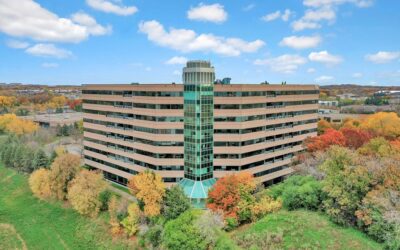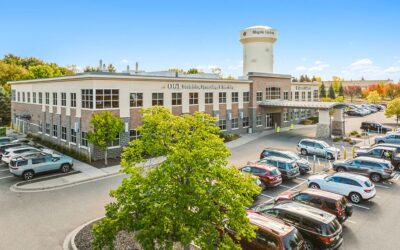NEWS POST
Lease Expiring in Two Years? See Our Lease Negotiation Tips
Eighteen months used to be plenty of time for lease negotiations, and to renovate or construct new space. Today, that may not be enough time. With longer construction timelines and continued supply chain constraints on technology components, any business with two years left on their lease should begin the evaluation to stay or relocate as soon as possible. For organizations considering a new development, two years is definitely not enough time.

Here’s a roadmap of what to do:
1. Evaluate your current lease language to understand your options
Most leases include a renewal window of 9-12 months’ notice to the landlord before expiration. However, that window doesn’t guarantee your landlord wants your business to remain a tenant. While it seems to make sense to let your landlord know in advance you want to stay, that conversation may also limit your negotiating power for key terms and conditions of your potential renewal.
If you’ve been in a space more than five years, you’ll be surprised by the level of complication that exists now when considering different space options. A well-thought-out strategy will reduce your overall costs and ensure that the space is a benefit and not a detriment to your organization. In some cases, the type of space you want – manufacturing or distribution in particular – may be out of reach given the limited number of available options in the industrial market.
2. Start reviewing your space priorities against your business goals
As soon as possible, gather key stakeholders and prioritize what’s most important in your space for the future. You’ll need to weigh the location, type of space, amenities, mix of gathering/communal space versus independent work desks. The best commercial real estate advisors (we recommend you use Forte!) will create a worksheet that ranks your options based upon your priorities. Caution: don’t make your decision-making group too big or too small. Too many stakeholders can become unwieldy and unable to make a decision; a small group may forget to consider a key driver.
Many companies are evaluating the type of space differently today than they did five years ago. Rather than simply looking at the cost per square foot, the number of workspaces, or how many private offices are needed, the business’s location now has to accommodate hybrid work schedules. Where amenities previously were nice-to-have, today they are crucial to support the business culture and collaboration. We’re seeing clients prioritize nearby amenities and pay more for a smaller footprint to ensure that the space reflects employee requests. While occupying fewer square feet may be the result, it might not result in spending less.
3. Options create leverage
Your adviser should be prepared to discuss and advocate for all options equally since even the best laid plans can be disrupted when the preferred location is no longer available. Some parameters may be beyond your control – including paying today’s price compared to the price when the original lease was signed.
The other reality is that the cost per sq. ft. to lease space, primarily with industrial properties, has increased by as much as 40% since 2021. Your landlord may not want to commit to extending your lease if they can lease to a new tenant who will pay more.
By considering both the cost/benefit of renovating and staying in existing space versus moving and renovating new space, you will have much more control over the process and the decision. A construction project manager will work with you to price out whether spaces will work for your company’s technology, accessibility, and collaboration needs. As part of the move vs. stay discussion, right sizing your suite needs to be considered, especially if the work requires less sq. ft. per person.
4. Have friends in construction, architecture, project management
With a strong real estate advisor, you’ll get the support of a team of vetted, thorough professionals – from architects, construction firms, interior designers, furniture reps and technology experts — who can help plan and budget for renovations in either existing or new space. You’ll also want a team that can carefully manage the landlord improvement contributions along with costs your firm may directly incur. At Forte, we have a deep bench of valued partners who can bring the project to life.
Those partners are familiar with the move toward hybrid work in the office, which also often creates more collaboration space. Consider: Will the company require specific days in the office or let employees decide? If all employees will be in the office at the same time, you’ll need to accommodate that in your calculations. Will new employees be based near your office, or will you recruit from anywhere? These answers will lead to the best possible outcome for your space.
5. Make sure your new space gives your organization flexibility for the future
While a longer lease may be required to negotiate the best terms from the landlord, negotiating flexibility is also critical. This can include a shorter initial term but also specific language for expanding or terminating your lease. Other ways to improve your flexibility include the configuration of the furniture or moveable walls.
Finally consider the impact of technology. Technology has evolved rapidly, impacting the design and layout of tenant spaces. From cloud-based servers that no longer need cabling required to each workstation, that technology will continue to impact organizations both financially and functionally.
Ultimately, given the state of flux in employee work habits and the changing landscape of commercial real estate, you’ll need a knowledgeable, passionate team to be your advocate and partner. Forte Real Estate Partners will assist you and your team to make the right decision for your organization today and into the future.
Written By: Jim Jetland, SIOR | Principal
Your Purpose. Our Passion.
Take a look at our Advisory Services page to see how our advisors can help you.
Advisory Services
Forte Real Estate Partners recognizes that each client’s real estate needs are unique to their business. Our experienced advisors listen to our clients, so they clearly understand the objectives, anticipate potential challenges, and work hard to exceed their expectations to provide solutions based upon our client’s best interests and current market conditions.
News & Updates
Founders Properties to move to 6,500 sq. ft. in Eden Prairie
NEWS POSTFounders Properties to move to 6,500 sq. ft. in Eden PrairieMinneapolis (June 23, 2025) – Founders Properties, a privately held real estate investment management firm, has decided to move out of its long-time Minnetonka home to 6,500...
Forte Real Estate Partners Recognized as one of MSP Business Journal’s Best Places to Work
NEWS POSTForte Real Estate Partners Recognized as one of MSP Business Journal's Best Places to WorkMinneapolis (June 16, 2025) – Forte Real Estate Partners has been recognized for the third year in a row as one of Minneapolis/St. Paul’s Business Journal’s Best Places...
Arbor Lakes Medical Office and Grove Medical Traded in May
NEWS POSTArbor Lakes Medical Office and Grove Medical Traded in MayForte’s Steve Brown acts as CBRE’s local market expert in salesMinneapolis (June 9, 2025) – Steve Brown, principal – Forte, joined CBRE’s U.S. Healthcare Capital Markets...




